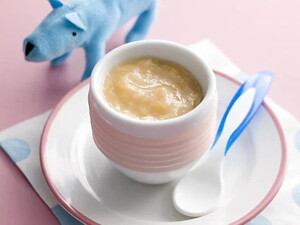Ingredients
Fruits and vegetables
Step by step
-
How to puree fruits and vegetables
Fruits and vegetables that require cooking
Suitable fruit - apples, apricots, dates, peaches, pears, plums, rhubarb (leaves completely removed), nectarines
Suitable vegetables – beans, carrots, cauliflower, broccoli, peas, squash, potato, parsnip, sweet potato, turnip, pumpkin, spinach, zucchini, mushrooms
1. Wash, peel (if necessary) and chop fruits or vegetables.
2. Place in a small saucepan; pour over enough water to cover; bring to the boil, simmer until tender.
3. Drain, reserving some of the cooking liquid. For younger babies, push fruit or vegetables through a sieve or blend in a blender until smooth, adding some of the reserved cooking liquid until the required consistency is reached. For older babies, simply mash with a fork, adding some of the reserved cooking liquid for a smoother consistency if required.
4. Puree can now be frozen for use at a later date.
5. For convenient quantities, place puree into ice cube trays and freeze. Each cube is equal to about 1 tablespoonful, which is just right for babies starting out.
NOTE: When using a frozen puree, ensure any uneaten portion is discarded. It is not suitable for refrigeration or freezing.
Fruits that don’t require cooking
Suitable fruits - avocados, bananas, melons, figs, mangoes, pawpaw, strawberries, tomatoes, blueberries, raspberries
1. Wash, peel (if necessary) and chop fruit, removing any seeds where needed.
2. For younger babies, push fruits though a sieve or blend in a blender until smooth, adding some cooled boiled water, until the required consistency is reached. For older babies, simply mash with a fork, adding some cooled boiled water for a smoother consistency, if required.
3. Uncooked fruits are not suitable to freeze, but can be refrigerated for up to 1 day.
-
Instructions
Fruits and vegetables that require cooking
Suitable fruit - apples, apricots, dates, peaches, pears, plums, rhubarb (leaves completely removed), nectarines
Suitable vegetables – beans, carrots, cauliflower, broccoli, peas, squash, potato, parsnip, sweet potato, turnip, pumpkin, spinach, zucchini, mushrooms
1. Wash, peel (if necessary) and chop fruits or vegetables.
2. Place in a small saucepan; pour over enough water to cover; bring to the boil, simmer until tender.
3. Drain, reserving some of the cooking liquid. For younger babies, push fruit or vegetables through a sieve or blend in a blender until smooth, adding some of the reserved cooking liquid until the required consistency is reached. For older babies, simply mash with a fork, adding some of the reserved cooking liquid for a smoother consistency if required.
4. Puree can now be frozen for use at a later date.
5. For convenient quantities, place puree into ice cube trays and freeze. Each cube is equal to about 1 tablespoonful, which is just right for babies starting out.
NOTE: When using a frozen puree, ensure any uneaten portion is discarded. It is not suitable for refrigeration or freezing.
Fruits that don’t require cooking
Suitable fruits - avocados, bananas, melons, figs, mangoes, pawpaw, strawberries, tomatoes, blueberries, raspberries
1. Wash, peel (if necessary) and chop fruit, removing any seeds where needed.
2. For younger babies, push fruits though a sieve or blend in a blender until smooth, adding some cooled boiled water, until the required consistency is reached. For older babies, simply mash with a fork, adding some cooled boiled water for a smoother consistency, if required.
3. Uncooked fruits are not suitable to freeze, but can be refrigerated for up to 1 day.



